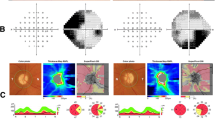Abstract
We report a case of linezolid-induced optic neuropathy with transient microcystic spaces in the inner retina. We observed the retina using Fourier-domain optical coherence tomography (FD-OCT) in a patient with linezolid-induced optic neuropathy. A 49-year-old woman presented to our department with a 1-week history of bilateral photophobia. At the first visit, her best-corrected visual acuity (VA) was 0.6 in the right eye and 0.5 in the left eye. She had moderate optic disk edema and central scotomas bilaterally. FD-OCT showed bilateral microcystic spaces in the retina. Microcystic spaces were seen in the retinal nerve fiber layer (RNFL) and at the border of the RNFL and the retinal ganglion cell layer. Magnetic resonance imaging and laboratory tests showed no positive findings except for an elevated lactic acid level. One week after the first visit, the VA levels decreased to 0.06 and 0.07 in the right and left eyes, respectively. Because the patient had a 7-month history of linezolid treatment for persistent pyogenic arthritis, we suspected linezolid-induced optic neuropathy and immediately terminated treatment with this drug. The optic disk edema and the microcystic spaces in the retina resolved, and the VA improved to 1.2 at 6 weeks after linezolid withdrawal. Microcystic spaces, which resolved with linezolid withdrawal, were observed in linezolid-induced optic neuropathy. The microcystic spaces in the inner retina can be the first retinal sign of some optic neuropathies.


Similar content being viewed by others
References
Dryden MS (2011) Linezolid pharmacokinetics and pharmacodynamics in clinical treatment. J Antimicrob Chemother 66 (Suppl 4): iv7–iv15
Rucker JC, Hamilton SR, Bardenstein D, Isada CM, Lee MS (2006) Linezolid-associated toxic optic neuropathy. Neurology 66:595–598
De Vriese AS, Coster RV, Smet J, Seneca S, Lovering A, Van Haute LL et al (2006) Linezolid-induced inhibition of mitochondrial protein synthesis. Clin Infect Dis 42:1111–1117
Javaheri M, Khurana RN, O’Hearn TM, Lai MM, Sadun AA (2007) Linezolid-induced optic neuropathy: a mitochondrial disorder? Br J Ophthalmol 91:111–115
Carelli V, Ross-Cisneros FN, Sadun AA (2002) Optic nerve degeneration and mitochondrial dysfunction: genetic and acquired optic neuropathies. Neurochem Int 40:573–584
Balk LJ, Killestein J, Polman CH, Uitdehaag BM, Petzold A (2012) Microcystic macular oedema confirmed, but not specific for multiple sclerosis. Brain 135(Pt 12): e226; author reply e227
Lujan BJ, Horton JC (2013) Microcysts in the inner nuclear layer from optic atrophy are caused by retrograde trans-synaptic degeneration combined with vitreous traction on the retinal surface. Brain 136(Pt 11):e260
Gelfand JM, Cree BA, Nolan R, Arnow S, Green AJ (2013) Microcystic inner nuclear layer abnormalities and neuromyelitis optica. JAMA Neurol 70:629–633
Saidha S, Sotirchos ES, Ibrahim MA, Mohamed A, Crainiceanu CM, Gelfand JM et al (2012) Microcystic macular oedema, thickness of the inner nuclear layer of the retina, and disease characteristics in multiple sclerosis: a retrospective study. Lancet Neurol 11:963–972
Barboni P, Carelli V, Savini G, Carbonelli M, La Morgia C, Sadun AA (2013) Microcystic macular degeneration from optic neuropathy: not inflammatory, not trans-synaptic degeneration. Brain 136(Pt 7):e239
Curcio CA, Allen KA (1990) Topography of ganglion cells in human retina. J Comp Neurol 300:5–25
Raff MC, Whitmore AV, Finn JT (2002) Axonal self-destruction and neurodegeneration. Science 296:868–871
Funding
The authors have no financial interest in any aspect of this report.
Author information
Authors and Affiliations
Corresponding author
Additional information
Supported by a Grant-in-Aid for Challenging Exploratory Research 23659803 (R.K.) from the Ministry of Education, Science, and Culture, Tokyo, Japan; and a Grant-in-Aid for Innovative Research in Life Science 25P01 (R.K.) from Asahikawa Medical University, Hokkaido, Japan.
Electronic supplementary material
Below is the link to the electronic supplementary material.
Rights and permissions
About this article
Cite this article
Ishii, N., Kinouchi, R., Inoue, M. et al. Linezolid-induced optic neuropathy with a rare pathological change in the inner retina. Int Ophthalmol 36, 761–766 (2016). https://doi.org/10.1007/s10792-016-0196-5
Received:
Accepted:
Published:
Issue Date:
DOI: https://doi.org/10.1007/s10792-016-0196-5




